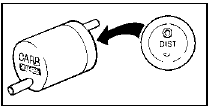Spark control system components (carburettor models) - removal and refitting
Spark delay and sustain valves 1 Disconnect the vacuum pipes at the valve and withdraw the valve.
2 When refitting a spark delay valve, the valve must be positioned with the black end (marked “CARB”) towards the carburettor and the coloured end (marked “DIST”) towards the distributor or electronic module (as applicable).
3 When refitting a spark sustain valve, the valve must be positioned with the end marked “VAC” towards the carburettor and the side marked “DIST” towards the distributor or electronic module (as applicable).
Ported vacuum switch
4 Where fitted, the switch(es) may be located
in the inlet manifold and/or in an adapter fitted
in one of the coolant hoses.
5 To remove a switch, partially drain the cooling system. Note that there is no need to remove the cylinder block drain plug.
6 Mark the vacuum pipes for location so that they can be refitted in their correct positions, then disconnect the pipes from the switch.
7 Unscrew the valve from its location.
8 Refitting is a reversal of removal, ensuring that the vacuum pipes are correctly connected. Refill the cooling system.
Fuel trap
9 Disconnect the vacuum pipes at the fuel
trap and withdraw the fuel trap.
10 When refitting, the fuel trap must be positioned with the black end (marked “CARB”) towards the carburettor, and the white side (marked “DIST”) towards the distributor, electronic module, or ported vacuum switch (as applicable) (see illustration).

22.10 Fuel trap vacuum connection markings
Spark control system additional
components
11 According to model, engine and
equipment, additional components such as
one-way valves or solenoids may also be
fitted as part of the spark control system.
12 The removal and refitting procedures for these components are basically as described previously, and provided that all attachments are marked for position prior to removal, no problems should be encountered.
See also:
Fuses and relays
Fuses
If electrical components in the
vehicle are not working, a fuse may
have blown. Blown fuses are
identified by a broken wire within
the fuse. Check the appropriate
fuses before replacing an ...
Ignition HT coil - testing, removal and refitting
Note: Refer to the precautions given in
Section 1 before proceeding.
All except models with DIS
ignition system
Testing
1 Accurate checking of the coil output
requires the use of special test eq ...
General information and precautions
Contact breaker ignition system
The ignition system is divided into two
circuits, low tension (primary) and high tension
(secondary). The low tension circuit consists of
the battery, ignition swit ...
